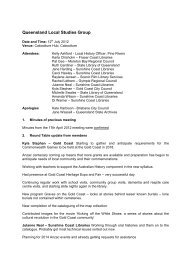Birds of Australia - Treasures from the collection - State Library of ...
Birds of Australia - Treasures from the collection - State Library of ...
Birds of Australia - Treasures from the collection - State Library of ...
You also want an ePaper? Increase the reach of your titles
YUMPU automatically turns print PDFs into web optimized ePapers that Google loves.
“How rapidly is this fine country unfolding her rich<br />
treasures …<strong>of</strong> which, indeed, sufficient have been seen to<br />
rank her second to none in <strong>the</strong> interest <strong>of</strong> her productions.”<br />
(Gould <strong>Birds</strong> <strong>of</strong> <strong>Australia</strong> vol 4 within <strong>the</strong> Pitta iris entry)<br />
List <strong>of</strong> works<br />
1. Paradise Regained: a 19th Century<br />
Glass Bird Dome Case<br />
On loan <strong>from</strong> <strong>the</strong> Queensland Museum<br />
Ornithologists and naturalists are excited by this<br />
case with its 25 mounted specimens as <strong>the</strong> male<br />
Paradise parrot (Psephotus pulcherrimus) is now<br />
an extinct species. A Mr W.J. Daniell who owned<br />
a draper’s store in Gympie acquired this case<br />
in <strong>the</strong> 1870s as payment <strong>of</strong> a debt. He believed<br />
<strong>the</strong> birds were all collected in <strong>the</strong> Gympie area.<br />
The case was considered very special and was<br />
exhibited in <strong>the</strong> 1890 Paris Universal Exposition.<br />
Around 1912 Daniell’s eldest daughter, Ann Mary,<br />
brought it to Brisbane and it remained in <strong>the</strong> family<br />
until December 1999 when two <strong>of</strong> his great grand<br />
daughters donated it to <strong>the</strong> Queensland Museum.<br />
2. John Gould (1804 – 1881)<br />
Synopsis <strong>of</strong> <strong>the</strong> <strong>Birds</strong> <strong>of</strong> <strong>Australia</strong><br />
and <strong>the</strong> adjacent islands, 1837 – 1838<br />
John Oxley <strong>Library</strong>,<br />
<strong>State</strong> <strong>Library</strong> <strong>of</strong> Queensland<br />
RBQ 598.2994 GOU<br />
This Synopsis was published by Gould in four<br />
parts (January and April 1837, January and April<br />
1838) and when bound toge<strong>the</strong>r has 73 handcoloured<br />
plates. The <strong>State</strong> <strong>Library</strong> <strong>of</strong> Queensland’s<br />
copy concludes with <strong>the</strong> eight page paper,<br />
‘Description <strong>of</strong> New Species <strong>of</strong> <strong>Australia</strong>n <strong>Birds</strong>’<br />
that Gould read to <strong>the</strong> Zoological Society, London<br />
in December 1837. He notes that most <strong>of</strong> <strong>the</strong><br />
birds are in <strong>the</strong> author’s <strong>collection</strong> but as he was<br />
yet to visit <strong>Australia</strong> that, On his return <strong>from</strong> his<br />
intended visit to <strong>Australia</strong> <strong>the</strong>se pages will be<br />
cancelled, and each species will be illustrated<br />
and described in accordance with <strong>the</strong> preceding<br />
portion <strong>of</strong> <strong>the</strong> present Synopsis. This Synopsis is<br />
not <strong>the</strong> <strong>Birds</strong> <strong>of</strong> <strong>Australia</strong> (August 1837, February<br />
1838) <strong>of</strong> which only two parts were published and<br />
<strong>the</strong> rest cancelled.<br />
3 – 5. John Gould (1804 – 1881)<br />
<strong>Birds</strong> <strong>of</strong> <strong>Australia</strong> Vols. I-III<br />
John Oxley <strong>Library</strong>,<br />
<strong>State</strong> <strong>Library</strong> <strong>of</strong> Queensland<br />
RBF 598.2994 GOU V1<br />
Gould’s <strong>Birds</strong> <strong>of</strong> <strong>Australia</strong> (1840– 1848) is one <strong>of</strong><br />
<strong>Australia</strong>’s key scientifi c and artistic documents<br />
and was created to be a rare collector’s item.<br />
Acclaimed as Gould’s most renowned production,<br />
it has helped to ensure <strong>Australia</strong>’s fame as a<br />
location <strong>of</strong> exotic fl ora and fauna. The <strong>State</strong><br />
<strong>Library</strong> is fortunate to possess this bound set and<br />
considers it a very special treasure.<br />
250 copies each with a total <strong>of</strong> 681 lithographic<br />
plates by various illustrators (<strong>of</strong> which 84 were<br />
by Elizabeth Gould and about 595 were by H.C.<br />
Richter) and text by John Gould were published<br />
in 36 parts between 1 December 1840 and 1848.<br />
The intention was that owners would have <strong>the</strong>m<br />
bound <strong>the</strong>m as seven volumes.<br />
The John Oxley <strong>Library</strong> acquired this set <strong>from</strong><br />
Philip McIlwraith Forrest’s large book <strong>collection</strong> in<br />
1936. Forrest was <strong>the</strong> son <strong>of</strong> John Forrest (1848 –<br />
1911), one time owner <strong>of</strong> <strong>the</strong> North <strong>Australia</strong><br />
Pastoral Company (Alexandria Downs, Inkerman,<br />
Woodstock). Philip, a retired grazier, lived at<br />
Bowen Terrace in New Farm, Brisbane during <strong>the</strong><br />
late 1930s and early 1940s. After his death on 14<br />
June 1964, his family home Chiverton in Toowong<br />
and more <strong>of</strong> his general <strong>collection</strong> was sold. <strong>State</strong><br />
<strong>Library</strong> staff are working to establish who owned<br />
<strong>the</strong> set before him and where it was bound.<br />
6. Envelope dated 2 July 1842 <strong>from</strong> John<br />
Gilbert to John Gould at 20 Broad Street,<br />
Golden Square, London.<br />
The envelope bears John Gilbert’s seal.<br />
Along <strong>the</strong> side in what is probably Gould’s<br />
hand is written call on Manning [?], Holborn [?]<br />
& see <strong>the</strong> Garden Island Kangaroo.<br />
In pencil Pres by A.H.Chisholm Sept.1940.<br />
John Oxley <strong>Library</strong>,<br />
<strong>State</strong> <strong>Library</strong> <strong>of</strong> Queensland<br />
OM81 – 100<br />
This envelope is intriguing and <strong>the</strong> source <strong>of</strong><br />
valuable new information which has come to<br />
light during preparation for this exhibit. Recently<br />
Dr Clemency Fisher <strong>of</strong> <strong>the</strong> National Museums,<br />
Liverpool wrote:<br />
The envelope is <strong>from</strong> Gilbert’s letter No.11<br />
<strong>from</strong> Perth to John Gould in London which<br />
was mentioned as having been received in<br />
a draft letter sent in August 1844(i) but is<br />
now apparently lost.<br />
Dr Clemency noted that it is not part <strong>of</strong> <strong>the</strong> Gilbert<br />
and Gould material which <strong>the</strong> 13th Earl <strong>of</strong> Derby<br />
bequea<strong>the</strong>d to <strong>the</strong> Museum (which he founded).<br />
Articles in <strong>the</strong> Times, London (2 July 1938 and<br />
17 September 1938) reveal how Alec H. Chisholm,<br />
who was President <strong>of</strong> <strong>the</strong> Field Naturalists Club <strong>of</strong><br />
Victoria, got <strong>the</strong> envelope. The fi rst article reports<br />
that while Chisholm was at a bird lover’s meeting<br />
in Middlesex, he stated it was his intention to fi nd<br />
out everything he could about Gould while in <strong>the</strong><br />
UK. The second article, which is not signed but<br />
clearly by him, claims <strong>the</strong> material came <strong>from</strong><br />
Gould’s family via Mrs Edelsten <strong>of</strong> Streatham and<br />
her two grandsons, Dr. G. Edelsten (Hants) and Dr.<br />
A Edelsten (Somerset), and would go into <strong>Australia</strong>n<br />
libraries. Aside <strong>from</strong> <strong>the</strong> envelope, Chisholm<br />
ga<strong>the</strong>red key documents including Lady Franklin’s<br />
diary and documents now in <strong>the</strong> Mitchell <strong>Library</strong>,<br />
Sydney and <strong>the</strong> National <strong>Library</strong> <strong>of</strong> <strong>Australia</strong>.<br />
For information regarding <strong>the</strong> missing letter,<br />
see Alec Chisholm’s article The story <strong>of</strong> John<br />
Gilbert (Emu vol 40. 1940, p 168) and Scientists
in nineteenth century <strong>Australia</strong>, a documentary<br />
history by Ann Moyal (Cassell, London, 1976<br />
pp 68 – 70) (i) National <strong>Library</strong> <strong>of</strong> <strong>Australia</strong><br />
manuscript no. 597<br />
7. Letter <strong>from</strong> John Gould to R. Denny Esq.<br />
Dated 15 April 1851 and addressed <strong>from</strong><br />
Gould’s residence at 20 Broad St. Golden<br />
Square, London.<br />
Double sided and attached to <strong>the</strong> front page <strong>of</strong><br />
Gould’s <strong>Birds</strong> <strong>of</strong> <strong>Australia</strong> vol 1.<br />
John Oxley <strong>Library</strong>,<br />
<strong>State</strong> <strong>Library</strong> <strong>of</strong> Queensland<br />
RBF 597.2994 GOU V1<br />
According to Dr Fisher (Liverpool Museum),<br />
R. Denny was a taxidermist <strong>from</strong> Leeds who<br />
worked on fl eas, ticks and lice. He and Gould<br />
corresponded frequently as Denny helped to<br />
sell Gould’s books including to <strong>the</strong> Gotts, one<br />
<strong>of</strong> whom is mentioned in <strong>the</strong> letter. One <strong>of</strong> <strong>the</strong><br />
Gotts had written a version <strong>of</strong> <strong>Birds</strong> <strong>of</strong> <strong>Australia</strong><br />
and subscribed to Gould’s works. This explains<br />
Gould’s suggestion to Denny that Gott be told that<br />
he needs this <strong>Birds</strong> <strong>of</strong> <strong>Australia</strong> as a continuation<br />
<strong>of</strong> what he currently has because perhaps it<br />
is more valuable than any <strong>of</strong> <strong>the</strong> o<strong>the</strong>rs. The<br />
Mr John McGillivray referred to was a natural<br />
history collector <strong>the</strong>n completing his two - volume<br />
Narrative <strong>of</strong> <strong>the</strong> Voyage <strong>of</strong> H.M.S Rattlesnake that<br />
recounted how items were ga<strong>the</strong>red <strong>from</strong> islands<br />
and <strong>the</strong> north coast <strong>of</strong> <strong>Australia</strong>. Earlier in April<br />
he had written to Gould asking for two pounds.<br />
McGillivray died broke in Sydney.<br />
8. Selection <strong>of</strong> eight birds’ eggs<br />
On loan <strong>from</strong> <strong>the</strong> Queensland Museum<br />
9. Squatter pigeon skin (Geophaps scripta)<br />
On loan <strong>from</strong> <strong>the</strong> Queensland Museum<br />
10. Regent bower bird skin male and female<br />
(Sericulus chrysocephalus)<br />
On loan <strong>from</strong> <strong>the</strong> Queensland Museum<br />
11. Silvester Diggles (1817 – 1880)<br />
The Ornithology <strong>of</strong> <strong>Australia</strong><br />
S. Diggles, Brisbane 1865 – 1868, 1870.<br />
<strong>Australia</strong>n <strong>Library</strong> <strong>of</strong> Art,<br />
<strong>State</strong> <strong>Library</strong> <strong>of</strong> Queensland<br />
RB 598.2994 1870<br />
This copy has hand painted illustrations.<br />
There is a typed folder adhered to <strong>the</strong> front<br />
endpaper titled, Companion to Gould’s handbook<br />
or Synopsis <strong>of</strong> <strong>the</strong> <strong>Birds</strong> <strong>of</strong> <strong>Australia</strong> which is <strong>the</strong><br />
title <strong>of</strong> a later book by Diggles.<br />
12 – 13. John Gould (1804 – 1881)<br />
<strong>Birds</strong> <strong>of</strong> <strong>Australia</strong> Vols. IV-V<br />
John Oxley <strong>Library</strong>,<br />
<strong>State</strong> <strong>Library</strong> <strong>of</strong> Queensland<br />
RBF 598.2994 GOU V1<br />
14. John Gould (1804 –1881)<br />
Facsimile <strong>of</strong> <strong>Birds</strong> <strong>of</strong> <strong>Australia</strong><br />
Landsowne, Melbourne, 1972 – 73<br />
John Oxley <strong>Library</strong>,<br />
<strong>State</strong> <strong>Library</strong> <strong>of</strong> Queensland<br />
RBF 598.2994 GOU V<br />
This is displayed as a comparison with Gould’s<br />
original Volume V.<br />
15. Anthony Alder (1838 –1915)<br />
17 <strong>Birds</strong> <strong>of</strong> Queensland, c.1906<br />
Oil on artist’s board, 542 x 425mm, signed LL<br />
John Oxley <strong>Library</strong>,<br />
<strong>State</strong> <strong>Library</strong> <strong>of</strong> Queensland<br />
Acc 4100<br />
Anthony Alder, who was trained as a wax and<br />
plaster caster, fi rst came to Brisbane <strong>from</strong> England<br />
in about 1863 and was in Far North Queensland<br />
sketching <strong>the</strong> following year. Later he returned to<br />
London and worked as a taxidermist for <strong>the</strong> family<br />
business, Alder and Co in Islington. His entry<br />
won <strong>the</strong> gold medal for mounted natural history<br />
specimens at <strong>the</strong> 1871 London Exhibition.<br />
Alder returned to Brisbane in August 1875 and<br />
operated as a taxidermist fi rst in Queen Street and<br />
<strong>the</strong>n in George Street. Alder did consultancy work<br />
for <strong>the</strong> Queensland Museum, illustrated for <strong>the</strong><br />
Queenslander between 1895 – 96 and in 1907 fi nally<br />
became taxidermist for <strong>the</strong> Queensland Museum.<br />
He made <strong>the</strong> Aboriginal campsite diorama which<br />
was used <strong>the</strong>re until 1985. In 1869 Gould gave<br />
Alder a copy <strong>of</strong> his Handbook to <strong>the</strong> <strong>Birds</strong> <strong>of</strong><br />
<strong>Australia</strong> (1865) and it is assumed Alder collected<br />
specimens for Gould. Unfortunately none <strong>of</strong> <strong>the</strong><br />
skins displayed in this exhibition are likely to have<br />
been prepared by Alder as he died in April 1915.<br />
16. Skins to illustrate <strong>the</strong> birds in Alder’s<br />
painting<br />
On loan <strong>from</strong> <strong>the</strong> Queensland Museum<br />
a. Gouldian fi nch (Erythura gouldiae) male and female<br />
b. Superb fairywren (Malurus cyaneus) male and female<br />
c. Spotted pardalote (Pardalotus punctatus) males<br />
d. Silvereye (Zosterops lateralis) females<br />
e. Red-backed fairywren (Malurus melanocephalus) male and<br />
female<br />
f. Chestnut-breasted mannikin (Lonchura castaneothorax) male<br />
and female<br />
g. Scarlet honeyeater (Myzomela sanguinolenta) male and female<br />
h. Redwinged parrot (Aprosmictus erythropterus) male<br />
17. Charles Gordon Sebastian Hirst<br />
(c. 1826 –1890)<br />
<strong>Australia</strong>n <strong>Birds</strong>, 1875<br />
Watercolour on paper, 350 x 500mm<br />
LL. painted (dal vero) C.G.S. Hirst, LR.<br />
Brisbane July 1875<br />
On frame: <strong>Australia</strong>n <strong>Birds</strong> painted <strong>from</strong> life<br />
<strong>from</strong> <strong>the</strong> Collection in <strong>the</strong> Botanical Gardens,<br />
Brisbane, Queensland. Green Finch P, Blue<br />
Mountain P, Brown Paroquet, Red Bill.<br />
John Oxley <strong>Library</strong>,<br />
<strong>State</strong> <strong>Library</strong> <strong>of</strong> Queensland<br />
Acc 4567<br />
Born in Yorkshire, C.G.S. Hirst arrived in Sydney<br />
about 1870. He described himself as an<br />
architect, artist and author and by 1873 Hirst was<br />
taking commissions to paint houses, churches<br />
or whatever <strong>the</strong> locals wanted in sou<strong>the</strong>rn<br />
Queensland. While not highly skilled, Hirst’s work<br />
has a directness that supports his pride in painting<br />
<strong>from</strong> <strong>the</strong> actual object. Fortunately he labelled<br />
and <strong>of</strong>ten dated his paintings. Research by Judith<br />
McKay shows Hirst lost <strong>the</strong> design competition<br />
for <strong>the</strong> Mooney Memorial Fountain which is still at<br />
<strong>the</strong> corner <strong>of</strong> Queen and Eagle Streets, Brisbane.<br />
Hirst died in South Brisbane during March 1890<br />
<strong>from</strong> an overdose <strong>of</strong> opium. The National <strong>Library</strong><br />
<strong>of</strong> <strong>Australia</strong>, <strong>the</strong> Mitchell <strong>Library</strong> in Sydney, <strong>the</strong><br />
Queensland Art Gallery, Queensland Museum and<br />
several private <strong>collection</strong>s also hold his work.<br />
18. John Gould (1804 – 1881)<br />
<strong>Birds</strong> <strong>of</strong> <strong>Australia</strong> Vol VI<br />
John Oxley <strong>Library</strong>,<br />
<strong>State</strong> <strong>Library</strong> <strong>of</strong> Queensland<br />
RBF 598.2994 GOU V1<br />
19. John Gould (1804 –1881)<br />
<strong>Birds</strong> <strong>of</strong> <strong>Australia</strong> Supplement 1869<br />
John Oxley <strong>Library</strong>,<br />
<strong>State</strong> <strong>Library</strong> <strong>of</strong> Queensland<br />
RBF 598.2994 GOU SUP<br />
The John Oxley <strong>Library</strong> purchased this in 1936 as<br />
part <strong>of</strong> <strong>the</strong> Philip McIlwraith Forrest Esq. <strong>collection</strong>.<br />
20. Neville W. Cayley (1886 –1950)<br />
What Bird is That?<br />
A Guide to <strong>the</strong> <strong>Birds</strong> <strong>of</strong> <strong>Australia</strong><br />
Angus & Robertson, Sydney 1931<br />
<strong>Australia</strong>n <strong>Library</strong> <strong>of</strong> Art,<br />
<strong>State</strong> <strong>Library</strong> <strong>of</strong> Queensland<br />
RBHMON CAY<br />
Neville William Cayley was <strong>the</strong> son <strong>of</strong> Neville<br />
H.P. Cayley who had also painted <strong>Australia</strong>n birds<br />
but with a more artistic than ornithological cast.<br />
After 1925 when his illustrations were included in<br />
<strong>the</strong> famous 1925 – 26 <strong>Australia</strong>n Encyclopaedia,
1 2 3 4<br />
Neville W. Cayley became <strong>Australia</strong>’s best known<br />
bird painter. In particular, his What Bird is That?<br />
A Guide to <strong>the</strong> <strong>Birds</strong> <strong>of</strong> <strong>Australia</strong> long remained a<br />
household fi xture ready to do duty on picnics or<br />
bush walks.<br />
21. Gregory M. Ma<strong>the</strong>ws (1876 –1949)<br />
The <strong>Birds</strong> <strong>of</strong> <strong>Australia</strong><br />
Wi<strong>the</strong>rby & Co, London, 1910 –1927<br />
Vol. 6, 1916 –17<br />
John Oxley <strong>Library</strong>,<br />
<strong>State</strong> <strong>Library</strong> <strong>of</strong> Queensland<br />
RBF 598.2994 MAT V6<br />
22. E.F. Robinson<br />
Photograph album, October 1918<br />
John Oxley <strong>Library</strong>,<br />
<strong>State</strong> <strong>Library</strong> <strong>of</strong> Queensland<br />
Acc 6673<br />
This private album records local Brisbane birds<br />
and animals and is typical <strong>of</strong> what a talented<br />
amateur photographer could technically achieve.<br />
23. Neville W. Cayley (1886 –1950)<br />
The Fairy Wrens <strong>of</strong> <strong>Australia</strong>: blue birds<br />
<strong>of</strong> happiness<br />
Angus & Robertson, Sydney 1949<br />
<strong>Australia</strong>n <strong>Library</strong> <strong>of</strong> Art,<br />
<strong>State</strong> <strong>Library</strong> <strong>of</strong> Queensland<br />
RBHMON CAY<br />
24. Penny Olsen<br />
Fea<strong>the</strong>r and brush: three centuries<br />
<strong>of</strong> <strong>Australia</strong>n bird art<br />
Melbourne, CSIRO, 2001<br />
John Oxley <strong>Library</strong>,<br />
<strong>State</strong> <strong>Library</strong> <strong>of</strong> Queensland<br />
Q 598.0222 OLS<br />
In 2002 this book won The <strong>Australia</strong>n’s Award for<br />
Excellence in Educational Publishing. Dr. Olsen is<br />
a Visiting Fellow at ANU and in 1997 was awarded<br />
<strong>the</strong> D.L. Serventy Medal for services to Ornithology.<br />
25. Ruth Venner (1944– )<br />
Alphabet Bird Book, 2000<br />
Concertina artist’s book folded to form pockets<br />
holding coloured photocopies<br />
<strong>of</strong> Venner’s illuminated drawings <strong>of</strong> birds.<br />
<strong>Australia</strong>n <strong>Library</strong> <strong>of</strong> Art,<br />
<strong>State</strong> <strong>Library</strong> <strong>of</strong> Queensland<br />
RBHMON VEN<br />
Ruth Venner came to <strong>Australia</strong> in 1972 and after<br />
travelling <strong>the</strong> continent became South <strong>Australia</strong>’s<br />
fi rst calligraphy teacher in 1982. Since 1991<br />
she has lived in Nor<strong>the</strong>rn New South Wales or<br />
Queensland and has exhibited at <strong>the</strong> Tweed River<br />
Regional Gallery, <strong>the</strong> Nimbin Regional Gallery, <strong>the</strong><br />
Gold Coast Art Gallery and <strong>the</strong> Redland Museum,<br />
Cleveland. Her work has also been seen in Britain,<br />
New Zealand, Germany, Canada and China. In<br />
1996 and 1997 she was included in <strong>the</strong> Bokugei<br />
Pictorial in Tokyo and in 1990, 1997 and 2006<br />
visited China to share ideas on calligraphy with<br />
artists and to exhibit her own work. She describes<br />
herself as artist, calligrapher, poet and writer.<br />
26. Mary Newsome (1936 – )<br />
Bird colours on creek scrolls, 2002<br />
Artist’s book published Villa Modeste<br />
Workshop, Melbourne<br />
Based on <strong>the</strong> artist’s book, A Creeky Labyrinth.<br />
ed. 2/20<br />
<strong>Australia</strong>n <strong>Library</strong> <strong>of</strong> Art,<br />
<strong>State</strong> <strong>Library</strong> <strong>of</strong> Queensland<br />
RBHMON NEW<br />
Mary Newsome lives in Melbourne but has travelled<br />
and studied in London and Paris. She exhibits<br />
with Gallery 101, Melbourne. Her work is also in<br />
<strong>the</strong> <strong>collection</strong>s <strong>of</strong> Monash University Rare Books<br />
Collection, <strong>the</strong> <strong>State</strong> <strong>Library</strong> <strong>of</strong> Victoria and <strong>the</strong> Art<br />
Galleries <strong>of</strong> New South Wales, Queensland and<br />
South <strong>Australia</strong>. In 2005 she won <strong>the</strong> Sou<strong>the</strong>rn<br />
Cross University Acquisitive Artists’ Book Award.<br />
Newsome became interested in artists’ books while<br />
in Paris during 1994.<br />
27. Kylie Stillman (1975 – )<br />
Dusky robin, 2004<br />
Artist’s book<br />
One paper sculpture, carved into book<br />
mounted on white board within a wooden<br />
frame on verso <strong>of</strong> frame: Code: KS 5023<br />
<strong>Australia</strong>n <strong>Library</strong> <strong>of</strong> Art,<br />
<strong>State</strong> <strong>Library</strong> <strong>of</strong> Queensland<br />
RBHMON STI<br />
Kylie Stillman was born in Mordialloc, trained at<br />
RMIT and still lives in Victoria. She also exhibits<br />
in Sydney, Tasmania and New Zealand. In 2006<br />
an <strong>Australia</strong> Council grant enabled her to use <strong>the</strong><br />
Council’s Studio in Milan. Her work is also held in <strong>the</strong><br />
special <strong>collection</strong>s <strong>of</strong> Fisher <strong>Library</strong> <strong>of</strong> <strong>the</strong> University<br />
<strong>of</strong> Sydney, Macquarie Bank and <strong>the</strong> <strong>State</strong> <strong>Library</strong> <strong>of</strong><br />
Victoria. For Stillman this book’s carved – away text<br />
creates a tone which mimics <strong>the</strong> absent creature’s<br />
markings and plumage which for her is <strong>the</strong> opposite<br />
<strong>of</strong> illustrations in bird watching manuals. Hence <strong>the</strong><br />
bird’s absence frees <strong>the</strong> viewer to have a personal<br />
interpretation <strong>of</strong> her artwork. She is represented by<br />
Utopia Art, Sydney.<br />
28. Prepared Albert’s lyrebird male<br />
(Menura alberti)<br />
On loan <strong>from</strong> <strong>the</strong> Queensland Museum<br />
Named for Prince Albert (Queen Victoria’s<br />
husband), this species is confi ned to south – east<br />
Queensland and nor<strong>the</strong>rn NSW. Its tail fea<strong>the</strong>rs<br />
are less developed than <strong>the</strong> Superb lyrebird and it<br />
inhabits a smaller geographical range.
What does an illustration and text in Gould’s <strong>Birds</strong> <strong>of</strong> <strong>Australia</strong> tell us?<br />
On <strong>the</strong> right hand page<br />
are Gould’s notes about <strong>the</strong><br />
bird.<br />
On <strong>the</strong> lower left hand<br />
corner is written J Gould<br />
and HC Richter del et lith.<br />
Platycercus splendidus,<br />
Gould, indicates that John<br />
Gould was <strong>the</strong> fi rst to name<br />
and describe this bird.<br />
It also gives <strong>the</strong> reference<br />
to where he fi rst described<br />
<strong>the</strong> bird as <strong>the</strong> Proceedings<br />
<strong>of</strong> <strong>the</strong> Zoological Society <strong>of</strong><br />
London, Part XIII.<br />
This shows that both Gould and<br />
H.C. Richter created <strong>the</strong> image.<br />
Gould did <strong>the</strong> original sketch,<br />
indicating colours and details,<br />
and H.C. Richter created <strong>the</strong><br />
design and hand painted it to<br />
Gould’s approval. Del is short for<br />
<strong>the</strong> Latin ‘delego’ to assign or to<br />
transfer, et is Latin for ‘and’ and<br />
lith, is short for lithography and<br />
originates <strong>from</strong> <strong>the</strong> ancient Greek<br />
word for stone.<br />
6<br />
On <strong>the</strong> lower right corner is written Hullmandel & Walton Imp.<br />
This identifi es <strong>the</strong> company that printed Gould and Richter’s<br />
lithograph. Hullmandel (1798 –1850) was one <strong>of</strong> London’s fi nest<br />
printers and printed <strong>the</strong> famous editions <strong>of</strong> Turner’s engravings.<br />
For those interested in bird watching<br />
• The Royal Australasian Ornithologists Union changed its name to <strong>Birds</strong> <strong>Australia</strong> in 1996.<br />
The <strong>Birds</strong> <strong>Australia</strong> Sou<strong>the</strong>rn Queensland branch has a quarterly newsletter, Rosella Ramblings and a<br />
useful website www.users.bigpond.com/basqld<br />
• The national journal The Emu was fi rst published in 1901 and is a leading journal for ornithological research<br />
and reviews in <strong>the</strong> Sou<strong>the</strong>rn Hemisphere. Online content can be found at www.publish.csiro.au/<br />
• The <strong>Birds</strong> Queensland website at www.birdsqueensland.org.au is run by <strong>the</strong> Queensland<br />
Ornithological Society and promotes <strong>the</strong> scientifi c study and conservation <strong>of</strong> birds.<br />
• John Gould’s <strong>Birds</strong> <strong>of</strong> <strong>Australia</strong> can be viewed online through <strong>the</strong> National <strong>Library</strong> <strong>of</strong> <strong>Australia</strong>’s website<br />
at www.nla.gov.au/apps/cdview?pi=nla.aus-f4773
Key Figures<br />
Alexander Hugh Chisholm (1890 –1977)<br />
Without A.H. Chisholm our knowledge <strong>of</strong> <strong>the</strong><br />
<strong>Australia</strong>n visit by John and Elizabeth Gould<br />
and John Gilbert would be poorer, and <strong>the</strong> key<br />
documents he collected during his 1938 visit<br />
to <strong>the</strong> UK as President <strong>of</strong> <strong>the</strong> Field Naturalists<br />
Club <strong>of</strong> Victoria may not now be in <strong>Australia</strong>n<br />
<strong>collection</strong>s. These included Lady Franklin’s diary,<br />
letters between John and Elizabeth Gould, and<br />
<strong>the</strong> diary John Gilbert kept on his fateful 1845<br />
journey with Leichhardt. Chisholm was born<br />
in Victoria, and had worked as a journalist in<br />
Brisbane, Sydney and Melbourne. He was editor<br />
<strong>of</strong> <strong>the</strong> Argus (Melbourne), <strong>the</strong> new edition <strong>of</strong> <strong>the</strong><br />
<strong>Australia</strong>n Encyclopaedia and Honorary editor <strong>of</strong><br />
The Emu, <strong>the</strong> Journal <strong>of</strong> <strong>the</strong> Royal Australasian<br />
Ornithologists’ Union (now <strong>Birds</strong> <strong>Australia</strong>).<br />
Some <strong>of</strong> Chisolm’s publications which pertain to<br />
this exhibition are: Bird Seeking in Queensland:<br />
1770 –1922 (1922); Strange Journey: <strong>the</strong><br />
adventures <strong>of</strong> John Gilbert and Ludwig Leichhardt<br />
(1941); Story <strong>of</strong> Elizabeth Gould (1944); and<br />
Explorer and his birds: John Gilbert’s discoveries<br />
in 1844 – 45 (1945).<br />
Silvester Diggles (1817 –1880)<br />
While little known today, Brisbane owes much to<br />
Diggles. Born in Liverpool, he settled in Brisbane<br />
after 1854 where he founded <strong>the</strong> Brisbane Choral<br />
and Philharmonic Societies. In 1862 he also<br />
helped to establish what was to become <strong>the</strong><br />
Queensland Museum. He supported himself by<br />
teaching music and drawing as well as repairing<br />
musical instruments. Aside <strong>from</strong> music and<br />
religion, Diggles’ interests were entomology and<br />
ornithology. As well as numerous articles on both<br />
fi elds, his major contribution is The Ornithology <strong>of</strong><br />
<strong>Australia</strong> (1865 – 68, 1870) which was published in<br />
21 parts, each containing six lithographed handcoloured<br />
plates <strong>of</strong> illustrations drawn ei<strong>the</strong>r by<br />
himself or his niece Rowena Birkett. In 1871 – 72<br />
Diggles travelled with <strong>the</strong> <strong>Australia</strong>n Eclipse<br />
Expedition to Cape Sidmouth in North Queensland.<br />
It appears that Diggles may have collected<br />
specimens for John Gould. To ensure cheaper<br />
access to Gould’s <strong>Birds</strong> <strong>of</strong> <strong>Australia</strong>, Diggles<br />
published <strong>the</strong> Companion to Gould’s handbook:<br />
or, Synopsis <strong>of</strong> <strong>the</strong> <strong>Birds</strong> <strong>of</strong> <strong>Australia</strong> (1877) which<br />
contained about one-third <strong>of</strong> <strong>the</strong> original examples.<br />
John Gilbert (1812 or 1815 –1845)<br />
John Gilbert worked as a taxidermist at <strong>the</strong><br />
Zoological Society <strong>of</strong> London with John Gould,<br />
and in 1838 was hired by Gould to accompany<br />
him to <strong>Australia</strong> as a collector. Initially <strong>the</strong>y worked<br />
toge<strong>the</strong>r in Tasmania until early 1839 when Gilbert<br />
left for <strong>the</strong> Swan River settlement. Five weeks after<br />
arriving in Perth, Gilbert reported to Gould that he<br />
had collected 200 birds, 25 skeletons and some<br />
skinned animals. His fi rst <strong>collection</strong> was shipped<br />
to London in May 1839 and ano<strong>the</strong>r was sent<br />
before he left in January 1840. After a brief return<br />
visit to London, Gilbert was back in Perth by July<br />
1841 and stayed 17 months collecting 432 bird<br />
specimens <strong>of</strong> which 32 were new fi nds to Western<br />
<strong>Australia</strong>. In January 1844 he returned to Sydney<br />
and spent six months travelling up to <strong>the</strong> Darling<br />
Downs where he found <strong>the</strong> Paradise Parrot.<br />
In 1845 Gould named this species Platycercus<br />
pulcherrimus. The Queensland Museum’s<br />
<strong>collection</strong>s include a journal, probably belonging<br />
to Gould’s secretary E.C. Prince, which shows<br />
that while Gilbert’s salary was £100 per year plus<br />
expenses, by 1842 he was receiving 10 percent<br />
<strong>of</strong> <strong>the</strong> relevant Gould book sales and some <strong>of</strong> <strong>the</strong><br />
specimens.<br />
Gilbert had heard <strong>of</strong> Leichhardt’s plan to go<br />
overland to Port Essington, and managed to<br />
convince a hesitant Leichhardt to let him join <strong>the</strong><br />
expedition. The group started <strong>from</strong> Jimbour on <strong>the</strong><br />
Darling Downs on October 1, 1844. Tragically on<br />
28 June <strong>the</strong> following year, Gilbert was killed by<br />
a fl ying spear when local Indigenous inhabitants<br />
made a night attack on <strong>the</strong> expedition’s camp at<br />
<strong>the</strong> base <strong>of</strong> Cape York. Leichhardt sent Gilbert’s<br />
diary and bird specimens on to Gould. Thanks to<br />
A.H. Chisholm this diary in now held in <strong>the</strong> <strong>State</strong><br />
<strong>Library</strong> <strong>of</strong> New South Wales’ Mitchell <strong>Library</strong>.<br />
See H.A. Chisholm, Strange New World: <strong>the</strong> adventure<br />
<strong>of</strong> John Gilbert and Ludwig Leichhardt (1941).<br />
John Gould (1804 –1881)<br />
John Gould was born in Dorset in 1804 and in<br />
1824 became a taxidermist in London, a career<br />
which provided a good living as stuffed birds and<br />
animals were considered refi ned interests amongst<br />
<strong>the</strong> upper classes. By 1827 Gould had become<br />
Curator and Preserver at <strong>the</strong> Museum <strong>of</strong> <strong>the</strong><br />
Zoological Society <strong>of</strong> London, a job which involved<br />
stuffi ng specimens and placing and describing<br />
<strong>the</strong>m within <strong>the</strong> hierarchical Linnean system <strong>of</strong><br />
Order, Family, Genus and Species. Gould quickly<br />
became an authority on birds and saw most <strong>of</strong><br />
<strong>the</strong> new exotic specimens and skins which came<br />
into London <strong>from</strong> all over <strong>the</strong> world. The term skin<br />
refers to a stuffed specimen without its skeleton<br />
and with its outer surface sewn toge<strong>the</strong>r.<br />
In 1829 Gould married Elizabeth Coxen (1804 –<br />
1841), a governess and talented amateur artist.<br />
John and Elizabeth began what would be a very<br />
lucrative international business. She studied<br />
lithography and toge<strong>the</strong>r <strong>the</strong>y produced and<br />
published A Century <strong>of</strong> <strong>Birds</strong> <strong>from</strong> <strong>the</strong> Himalaya<br />
Mountains (1830 –32) with 80 <strong>of</strong> her illustrations.<br />
In <strong>the</strong> next few years Gould established himself<br />
as an expert naturalist and successful publisher,<br />
and played a part in Charles Darwin’s fi ndings on<br />
evolution. By comparing <strong>the</strong> specimens Darwin<br />
showed at <strong>the</strong> Geological Society in London on 4<br />
January 1837 with o<strong>the</strong>rs, Gould found <strong>the</strong> birds<br />
were not wrens as Darwin thought but a new<br />
species <strong>of</strong> fi nches specifi c to certain Galapagos<br />
Islands. Darwin relied on this discovery in his key<br />
report, Zoology <strong>of</strong> <strong>the</strong> Voyage <strong>of</strong> H.M.S Beagle,<br />
Part III.<br />
Ano<strong>the</strong>r <strong>of</strong> <strong>the</strong> Goulds’ projects was <strong>the</strong> fi ve<br />
volume <strong>Birds</strong> <strong>of</strong> Europe (1837) with 3000 plates.<br />
Edward Lear, <strong>of</strong> The Owl and <strong>the</strong> Pussy Cat fame,<br />
had started this but, needing money, sold his<br />
plates to Gould. Later on Gould occasionally used<br />
Lear as an illustrator. Gould also produced <strong>the</strong><br />
four part Synopsis <strong>of</strong> <strong>the</strong> <strong>Birds</strong> <strong>of</strong> <strong>Australia</strong> and <strong>the</strong><br />
Adjacent Islands (1837) which had 73 plates and<br />
showed 168 bird heads.<br />
In 1838 Gould gave up his post at <strong>the</strong> Zoological<br />
Society and headed for <strong>Australia</strong>. Accompanied<br />
by Elizabeth, <strong>the</strong>ir eldest son Henry, <strong>the</strong> collector<br />
John Gilbert and <strong>the</strong>ir servants, Gould landed<br />
in Van Diemen’s Land (Tasmania) in September<br />
1838. Gould and Gilbert collected <strong>the</strong>re for several<br />
months before Gould left for Sydney in February<br />
1839 and Gilbert was sent to collect specimens<br />
near Perth. Elizabeth’s two bro<strong>the</strong>rs had settled at<br />
Yarrundi in NSW and Gould went to visit <strong>the</strong>m and<br />
work around <strong>the</strong> Liverpool Ranges. After briefl y<br />
returning to Tasmania for <strong>the</strong> birth <strong>of</strong> ano<strong>the</strong>r<br />
son, Gould travelled to Adelaide to meet up with<br />
Charles Sturt, Surveyor-General <strong>of</strong> South <strong>Australia</strong>,<br />
who was going down <strong>the</strong> Murray River. Toge<strong>the</strong>r<br />
<strong>the</strong>y visited <strong>the</strong> Murray Scrub area, Kangaroo<br />
Island and Mount L<strong>of</strong>ty Range. Gould <strong>the</strong>n took<br />
his family to Yarrundi to visit Elizabeth’s bro<strong>the</strong>rs<br />
before returning to London in August 1840.<br />
Elizabeth died <strong>the</strong> following year aged 37 after <strong>the</strong><br />
birth <strong>of</strong> her eighth child.<br />
Toge<strong>the</strong>r with his collectors Gould collected over<br />
800 birds and about 70 examples <strong>of</strong> quadrupeds.<br />
300 new species were discovered, however some
Before John Gould<br />
Taxonomy<br />
were subsequently downgraded to subspecies<br />
(although many still keep <strong>the</strong>ir Gouldian names).<br />
Interestingly, Gould introduced <strong>the</strong> budgerigar – a<br />
corruption <strong>of</strong> <strong>the</strong> Aboriginal name – to Britain.<br />
Gould had a rare combination <strong>of</strong> knowledge, ability<br />
and business sense. As a respected naturalist he<br />
advanced science and exploited <strong>the</strong> wonderful<br />
possibilities coloured lithography afforded books<br />
designed for rich collectors.<br />
As well as <strong>Birds</strong> <strong>of</strong> <strong>Australia</strong> (1840–1848) and its<br />
Supplement (1869), Gould went on to produce<br />
many more books including A monograph <strong>of</strong> <strong>the</strong><br />
Macropodidae, or family <strong>of</strong> kangaroos (1841–43)<br />
and The Mammals <strong>of</strong> <strong>Australia</strong> (1845–63). By 1866<br />
Gould had at least 1000 subscribers <strong>from</strong> all over<br />
<strong>the</strong> world for his publications.<br />
Gould had suffered poor health for some years<br />
and died in 1881. His <strong>collection</strong> <strong>of</strong> <strong>Australia</strong>n<br />
specimens is held in <strong>the</strong> Academy <strong>of</strong> Natural<br />
Sciences, Philadelphia as <strong>the</strong> British Museum<br />
claimed it could not afford to acquire <strong>the</strong>m.<br />
Fortunately, <strong>the</strong> Museum was able to afford<br />
<strong>the</strong> remaining 12,395 specimens (including his<br />
hummingbirds) which gives Gould a continued<br />
presence in London where he lived and worked.<br />
Gregory Macalister Ma<strong>the</strong>ws (1876 –1949)<br />
Although Ma<strong>the</strong>ws was educated at <strong>the</strong> Kings<br />
School, Parramatta, and jackarooed in Far North<br />
Queensland, his obsession for <strong>Australia</strong>n birds<br />
began during a visit to <strong>the</strong> British Museum after he<br />
and his wife went to live a hunting and fi shing life<br />
in England. Ma<strong>the</strong>ws began to amass a <strong>collection</strong><br />
<strong>of</strong> skins and some 5000 books <strong>from</strong> which he<br />
had mastered enough information by 1910 to<br />
produce volume one <strong>of</strong> his <strong>Birds</strong> <strong>of</strong> <strong>Australia</strong>. The<br />
fi nal twelfth volume appeared in 1927 but two<br />
supplements followed. From 1912 –1927 Ma<strong>the</strong>ws<br />
privately published The Austral Avian Record. He<br />
returned to <strong>Australia</strong> between 1939 and 1946<br />
and assisted <strong>the</strong> National <strong>Library</strong> <strong>of</strong> <strong>Australia</strong> in<br />
organising his gift <strong>of</strong> papers and books. Ma<strong>the</strong>ws’<br />
trinomial naming system to account for geographic<br />
differences in species remains controversial<br />
but eased <strong>the</strong> diffi culty <strong>of</strong> reclassifying Gould’s<br />
incorrectly identifi ed new species as sub-species.<br />
Ma<strong>the</strong>ws’ <strong>collection</strong> <strong>of</strong> some 40,000 specimens<br />
was second largest to Gould’s and, unfortunately<br />
as with Gould’s, was sold to a <strong>collection</strong> in <strong>the</strong><br />
USA. His The <strong>Birds</strong> <strong>of</strong> <strong>Australia</strong> is <strong>the</strong> last <strong>of</strong> <strong>the</strong><br />
very large folio colour plate productions to emulate<br />
Gould’s.<br />
John Gould’s responses to <strong>Australia</strong>n fl ora and<br />
fauna were informed by two key philosophical<br />
and scientifi c paradigms <strong>of</strong> his day. First was <strong>the</strong><br />
perception that <strong>Australia</strong>’s remoteness and <strong>the</strong><br />
exoticism <strong>of</strong> its species could provide <strong>the</strong> missing<br />
links to <strong>the</strong> Enlightenment’s notion <strong>of</strong> Natural<br />
Order. The second was <strong>the</strong> Swedish naturalist,<br />
Carolus Linnaeus’ (1707 –1778) taxonomy<br />
or system for structuring living things into a<br />
hierarchical order.<br />
Even before 1500, European thought had<br />
positioned Terra Incognita (which became<br />
<strong>Australia</strong>) ei<strong>the</strong>r as a blessed Paradise where <strong>the</strong><br />
lost tribe <strong>of</strong> Israel might be found or an accursed<br />
place. This split persisted and even Erasmus<br />
Darwin (1731 –1802), who was Charles’ learned<br />
grandfa<strong>the</strong>r, concluded that as kangaroos must be<br />
a cross between rabbits and rats, kangaroos and,<br />
by extension, <strong>Australia</strong>, were bizarre and unnatural.<br />
To some, <strong>the</strong> plausible explanation for kangaroos<br />
and fl ightless birds was that God had created<br />
<strong>Australia</strong> after <strong>the</strong> seventh day just to show that<br />
he could. Whatever <strong>the</strong> reason, <strong>Australia</strong> was a<br />
continent that fascinated science, and indeed was<br />
<strong>the</strong> fi rst to be explored for science.<br />
William Dampier convinced <strong>the</strong> Royal Society<br />
in 1699 to sponsor his second voyage and<br />
<strong>the</strong> inclusion <strong>of</strong> <strong>the</strong> fi rst trained illustrator to<br />
accompany such a trip. Dampier’s 1703<br />
account, Voyage to New Holland, provided <strong>the</strong><br />
impetus for Joseph Banks’ forceful insistence<br />
that Daniel Solander a zoologist, and Sydney<br />
Parkinson, an illustrator, accompany him on<br />
Cook’s fi rst voyage (1768 –71). Parkinson was <strong>the</strong><br />
fi rst to list Aboriginal names <strong>of</strong> birds and prepared<br />
A Vocabulary <strong>of</strong> <strong>the</strong> People <strong>of</strong> New Holland. Their<br />
effort recorded over 90 species <strong>of</strong> <strong>Australia</strong>n birds.<br />
Interest boomed and John Latham’s General<br />
Synopsis <strong>of</strong> <strong>Birds</strong> (1801) attempted to name all<br />
<strong>Australia</strong>n birds by comparing several <strong>collection</strong>s<br />
<strong>of</strong> skins in London. More examples were collected<br />
by Ferdinand Bauer and Robert Brown when <strong>the</strong>y<br />
sailed with Ma<strong>the</strong>w Flinders on The Investigator<br />
in 1801. Indeed, well before Gould arrived in<br />
<strong>Australia</strong> in 1838, <strong>the</strong> painter John Lewin had<br />
produced <strong>Birds</strong> <strong>of</strong> New Holland, <strong>the</strong> fi rst book<br />
with colour plates to be published in <strong>Australia</strong>. A<br />
fi re destroyed most <strong>of</strong> Lewin’s 1808 production<br />
but he republished in 1813 and later Gould<br />
revised its 1838 edition. By this time about half<br />
<strong>of</strong> <strong>the</strong> <strong>Australia</strong>’s 745 species were recorded and<br />
collecting birds, fl ora and fauna was big business.<br />
A brief introduction to taxonomy is useful in order<br />
to understand <strong>the</strong> names Gould and o<strong>the</strong>rs apply.<br />
Like every naturalist, Gould was indebted to<br />
Carolus Linnaeus. While hardly <strong>the</strong> fi rst to try and<br />
order <strong>the</strong> world, Linnaeus became famous for his<br />
universal hierarchical family tree which found a<br />
place for all living matter within set categories.<br />
For instance <strong>the</strong> Black-headed Pardalote is<br />
classifi ed as:<br />
Kingdom Animalia<br />
Phylum (division) Cordata<br />
Class<br />
Aves (bird)<br />
Order<br />
Passeriformes<br />
Family<br />
Pardalotidae<br />
Genus<br />
Species<br />
Pardalotus<br />
P.melanocephalus (under<br />
debate as a sub-species)<br />
Passeriformes is <strong>the</strong> Order for almost half <strong>the</strong> bird<br />
species known as perching birds. This grouping<br />
is partly based on <strong>the</strong>ir throat construction which<br />
enables <strong>the</strong>m to sing, <strong>the</strong> anatomy <strong>of</strong> <strong>the</strong>ir feet<br />
which have three toes pointing forward and one<br />
pointing backward, and that <strong>the</strong>y eat honey (nonpassarines<br />
do not). Most passeriformes have<br />
coloured eggs and it is now thought that most<br />
originated in Gondwana.<br />
Scientists continue to refi ne <strong>the</strong>se categories and<br />
invent more names. A general introduction can be<br />
found on <strong>the</strong> Wikipedia website at<br />
www.en.wikipedia.org/wiki/Bird classification
Acknowledgements<br />
Individuals and organisations<br />
Peter Crow,<br />
<strong>Birds</strong> Queensland<br />
Dez Wells,<br />
<strong>Birds</strong> <strong>Australia</strong> Sou<strong>the</strong>rn Queensland<br />
Steve van Dyck and Hea<strong>the</strong>r Janetzki,<br />
Queensland Museum<br />
Dr. Clemency Fisher,<br />
National Museums, Liverpool, UK<br />
Rosemary Kunst,<br />
Queensland Newspapers <strong>Library</strong><br />
<strong>State</strong> <strong>Library</strong> <strong>of</strong> Queensland<br />
Kim Barrett, Dianne Byrne, Helen Cole, Robyn<br />
Daw, Lydia Egunnike, Naomi Elliott, Simon Farley,<br />
Sue Furness, Lea Giles-Peters, Reina Irmer, Troy<br />
Keith, Janie Meadows, Bryony Nainby, Sharon<br />
Nolan, Jo Ritale, Fe Skoufa, Irene Sourgnes, Deb<br />
Stumm, Helen Thiselton, Rhiannon Walker<br />
Graphic designer<br />
Jackie Robinson<br />
The <strong>State</strong> <strong>Library</strong> <strong>of</strong> Queensland wishes to thank<br />
<strong>the</strong> Queensland Museum for generously lending<br />
items <strong>from</strong> its <strong>collection</strong>s.<br />
The <strong>Birds</strong> <strong>of</strong> <strong>Australia</strong> exhibition and text were<br />
prepared by Nancy Underhill.<br />
© <strong>State</strong> <strong>Library</strong> <strong>of</strong> Queensland<br />
Cover illustration:<br />
Ptilonorhynchus holosericeus, Kuhl. (Satin bowerbird)<br />
Images:<br />
1. Platycercus ignitus, Leadb:. (Fiery parakeet)<br />
2. Pardalotus melanocephalus, Gould. (Black-headed<br />
pardalote)<br />
3. Malurus amabilus, Gould. (Lovely wren)<br />
4. Platalea regia, Gould.<br />
(Royal spoonbill)<br />
5. Menura superba, Shaw. (Lyre-bird)<br />
6. Platycercus splendidus, Gould. (Splendid parakeet)<br />
All plates and pages <strong>from</strong> The <strong>Birds</strong> <strong>of</strong> <strong>Australia</strong>:<br />
in seven volumes by John Gould (1804 –1881)<br />
5


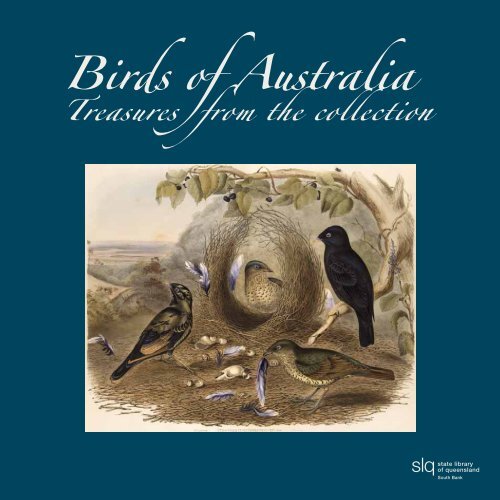
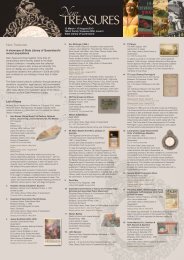
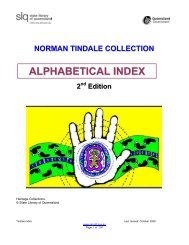


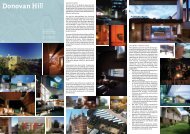
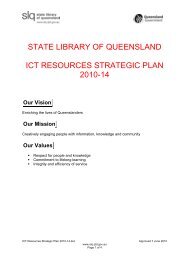
![2009-10 [ 13 MB] - State Library of Queensland - Queensland ...](https://img.yumpu.com/26312803/1/184x260/2009-10-13-mb-state-library-of-queensland-queensland-.jpg?quality=85)
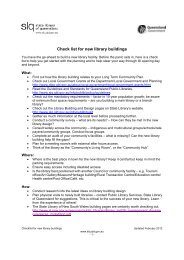
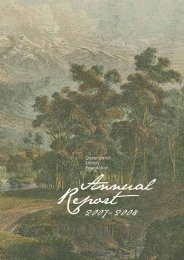
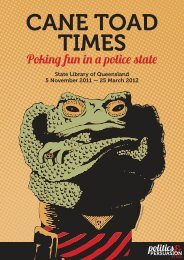
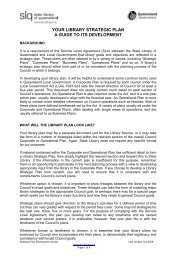
![2011-12 Part 4 [PDF 3.0 MB] - State Library of Queensland](https://img.yumpu.com/26312768/1/190x135/2011-12-part-4-pdf-30-mb-state-library-of-queensland.jpg?quality=85)
![Full room brochure [ (PDF 1.3 MB)] - State Library of Queensland](https://img.yumpu.com/26312762/1/190x101/full-room-brochure-pdf-13-mb-state-library-of-queensland.jpg?quality=85)
